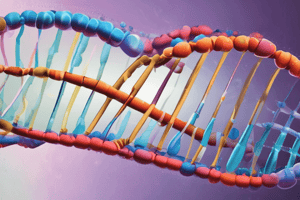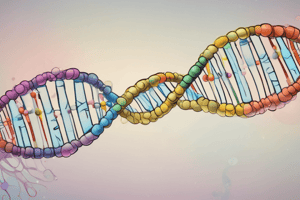Podcast
Questions and Answers
What is the minimum number of polypeptides required for DNA polymerase III functional activity?
What is the minimum number of polypeptides required for DNA polymerase III functional activity?
- One
- Two
- Five
- Three (correct)
Who discovered DNA polymerase I in 1958?
Who discovered DNA polymerase I in 1958?
- Arthur Kornberg (correct)
- Francis Crick
- James Watson
- Rosalind Franklin
What is the role of DNA ligase in DNA replication?
What is the role of DNA ligase in DNA replication?
- Forming phosphodiester bonds (correct)
- Unwinding of parental DNA
- Synthesizing RNA primers
- Initiating DNA synthesis
What is the approximate length of Okazaki fragments in prokaryotic cells?
What is the approximate length of Okazaki fragments in prokaryotic cells?
Which DNA polymerase is involved in the replication of mitochondrial DNA?
Which DNA polymerase is involved in the replication of mitochondrial DNA?
What is the primary function of DNA polymerase delta?
What is the primary function of DNA polymerase delta?
Which DNA polymerase is responsible for initiating nuclear DNA synthesis?
Which DNA polymerase is responsible for initiating nuclear DNA synthesis?
What is the primary function of DNA polymerase beta?
What is the primary function of DNA polymerase beta?
What is the key characteristic of semi-conservative replication?
What is the key characteristic of semi-conservative replication?
What is the main problem with conservative and dispersive replication?
What is the main problem with conservative and dispersive replication?
What is the function of CsCl2 equilibrium density gradient centrifugation in the Meselson and Stahl experiment?
What is the function of CsCl2 equilibrium density gradient centrifugation in the Meselson and Stahl experiment?
What is the difference between 14N and 15N ammonium salts?
What is the difference between 14N and 15N ammonium salts?
What is the significance of the Watson and Crick DNA model?
What is the significance of the Watson and Crick DNA model?
What is the characteristic of DNA from E. coli cells grown with 15N ammonium salts?
What is the characteristic of DNA from E. coli cells grown with 15N ammonium salts?
What is the purpose of the Meselson and Stahl experiment?
What is the purpose of the Meselson and Stahl experiment?
What is the characteristic of prokaryotic organisms?
What is the characteristic of prokaryotic organisms?
Which DNA polymerase appears to take part in nuclear replication of both the leading and the lagging strands?
Which DNA polymerase appears to take part in nuclear replication of both the leading and the lagging strands?
What type of replication occurs in eukaryotes?
What type of replication occurs in eukaryotes?
What is the function of replication licensing factor (RLF)?
What is the function of replication licensing factor (RLF)?
How many replication origins are estimated to be in a dividing human somatic cell?
How many replication origins are estimated to be in a dividing human somatic cell?
What is the term for the bulges where the DNA is in the process of division?
What is the term for the bulges where the DNA is in the process of division?
How does DNA replication occur in eukaryotes?
How does DNA replication occur in eukaryotes?
What is the function of other DNA polymerases?
What is the function of other DNA polymerases?
How are the new strands synthesized in eukaryotic DNA replication?
How are the new strands synthesized in eukaryotic DNA replication?
What determines the migration position of DNA in centrifugation?
What determines the migration position of DNA in centrifugation?
What was the result of switching E.coli to 14N media after growing them in 15N salts?
What was the result of switching E.coli to 14N media after growing them in 15N salts?
What is the mode of DNA replication supported by the results of Meselson and Stahl's experiment?
What is the mode of DNA replication supported by the results of Meselson and Stahl's experiment?
What is the function of DNA polymerase in DNA replication?
What is the function of DNA polymerase in DNA replication?
What is the role of RNA primers in DNA replication?
What is the role of RNA primers in DNA replication?
What is the function of helicase in DNA replication?
What is the function of helicase in DNA replication?
What is the name of the complex that constitutes helicase and primase?
What is the name of the complex that constitutes helicase and primase?
What is the name of the protein that melts duplex DNA in the oriC region?
What is the name of the protein that melts duplex DNA in the oriC region?
What is the purpose of DNA replication?
What is the purpose of DNA replication?
What is the base pairing rule in DNA replication?
What is the base pairing rule in DNA replication?
What happens to the two DNA strands in the first stage of replication?
What happens to the two DNA strands in the first stage of replication?
What is the replication fork?
What is the replication fork?
What is the result of DNA replication?
What is the result of DNA replication?
How many nucleotides per second are synthesized in E. coli?
How many nucleotides per second are synthesized in E. coli?
What is the role of the replisome?
What is the role of the replisome?
Flashcards
DNA Replication
DNA Replication
Two-stage process at the replication fork involving strand separation and new strand synthesis using parental strands as templates.
Semi-Conservative Replication
Semi-Conservative Replication
Each of the progeny conserves half of the original DNA molecule. One parental strand is conserved in each new double helix.
Meselson and Stahl Experiment
Meselson and Stahl Experiment
Experiment that confirmed semi-conservative replication. Used 15N and 14N isotopes to track DNA density through generations.
Mechanism of DNA Replication
Mechanism of DNA Replication
Signup and view all the flashcards
E. coli DNA Synthesis Steps
E. coli DNA Synthesis Steps
Signup and view all the flashcards
Prokaryotic vs. Eukaryotic Replication
Prokaryotic vs. Eukaryotic Replication
Signup and view all the flashcards
Replication Licensing Factor (RLF)
Replication Licensing Factor (RLF)
Signup and view all the flashcards
Study Notes
DNA Replication
- DNA replication is a two-stage process that occurs at the replication fork
- The first stage separates the two DNA strands of the parental DNA molecule
- The second stage builds two new strands using each of the two original strands as templates
- Base pairing occurs between A and T, and between G and C
- Each of the separated parental strands of DNA serves as a template strand for the synthesis of a new complementary strand
- Synthesis of both new strands of DNA occurs at the replication fork that moves along the parental molecule
Semi-Conservative Replication
- There are three possible strategies for replication of the double helix: semi-conservative, conservative, and dispersive
- Semi-conservative replication is the most satisfactory mechanism, as it allows for copying the information in the sequence of bases
- In semi-conservative replication, each of the progeny conserves half of the original DNA molecule
- One of the two “daughter” double helices consists entirely of original DNA strands, while the other helix consists of two newly synthesized strands
Meselson and Stahl Experiment
- In 1958, Meselson and Stahl performed an experiment to determine the mode of replication
- They grew E. coli in 15N ammonium salts, which resulted in DNA with a higher density than normal DNA
- When they switched the media to 14N salts, the DNA density changed
- After one round of replication, a single band of intermediate density was observed
- After a second round of replication, two bands were present in approximately equimolar amounts
- The results were consistent with a semi-conservative mode of replication for DNA
Mechanism of DNA Replication
- The process involves deoxyribonucleotide precursors synthesis, deoxynucleotide polymerization, and enzymes and proteins such as DNA polymerase, primase, and ligase
- RNA primers are also involved in the process
- The steps in E. coli DNA synthesis include:
- dnaA protein melts duplex in oriC region
- dnaB (helicase) and dnaC protein bind to replication fork
- Single-strand binding protein (ssb protein) binds to separated strands of DNA
- Primase complexes with helicase and creates RNA primers
- DNA pol III holoenzyme extends the RNA primer on the leading strand
Prokaryotic and Eukaryotic Replication
- Prokaryotic replication occurs in bacteria, while eukaryotic replication occurs in eukaryotic cells such as plants and animals
- Eukaryotic chromosomes are longer and have multiple replication origins scattered along each chromosome
- Replication is bi-directional, with a pair of replication forks starting at each origin of replication
- Eukaryotic DNA replication involves multiple DNA polymerases, including alpha, delta, gamma, and epsilon
Replication Licensing Factor (RLF)
- RLF is a protein complex that binds to the DNA next to each origin before each replication cycle
- RLF is displaced during replication and ensures that each origin initiates once and once only during each replication cycle
Studying That Suits You
Use AI to generate personalized quizzes and flashcards to suit your learning preferences.




